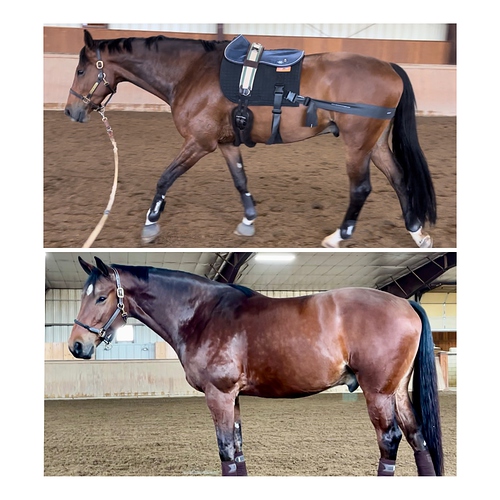Horse: 16.1 hh 2007 New Mexico-bred TB, sound, mostly sane, barefoot, lived on the range w/ broodmares and cattle from his 45-day Cowboy Training™️ at age three until age nine when his owners gave him to me in 2016. Then, he had a TB walking-around-his-whole-life topline, so not great, but not terrible, plus a small, but recognizable roach.
Me: formerly a good rider w/ excellent dressage fundamentals, now 65 – so, meh🤷🏻♀️ – semi-retired teacher currently on a low, low budget. I’m basically a working student for a local dressage barn to keep my horse housed and earn lessons.
As of about a month ago, and for the first time, TB has an actual topline and his roach is all but gone. I can see it because I know it’s there, but there is clear muscle attachment at his loin, and I am over the moon.
It’s been a long struggle to fit him for a saddle, mostly because of my budget. I ran through three used saddles before I found an ancient proto-Schleese and had it fitted correctly about five months ago.
Almost simultaneously, I put him on a compounded glucosamine injection that my vet formulates. We decided to do it when an intermittent right front gimp prompted x-rays and showed a little arthritis. TB gets it once a month.
I’ve also scheduled regular lessons, more consistently than in decades. We ride in a lesson every week, sometimes twice, unless it’s pouring rain. My work for the ranch/barn is the only thing that has made this possible, and I never want to stop. When it’s just me and TB working away, I am way too impressed, way too easily. My instructors both know what TB and I can do, and they push for it.
For my horse, it has taken the combination of two, maybe all three, adjustments: serious attention to his saddle, sticking to a lesson schedule, and though I wouldn’t guarantee that the injections are helping, my hunch – which is all I have RN – is that they are. (n.b. I haven’t changed his diet at all. He’s a ridiculously easy keeper, a little chunky on one orchard and two alfalfa flakes per day.)
So, altogether, it has taken some eight years to put a topline on this horse. I’m a million percent sure you can do it for yours much, much more quickly.



